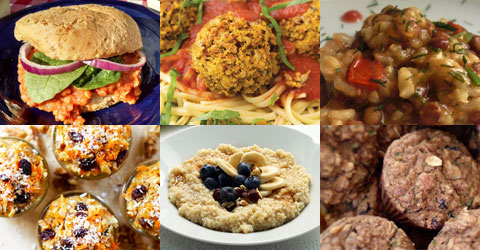

Whole grains are an important part of a healthy diet, providing the complex carbohydrates that our bodies prefer as their main source of energy, as well as fiber and an assortment of vitamins, minerals, and other micronutrients. Unlike processed grain products like white rice and white bread, whole grains actually help to control our weight by making us feel full longer. Yet, many people don’t know how to cook whole grains and are intimidated by the process.
Here’s the good news: There are some easy ways to add whole grains to your diet, and most are very simple to cook.
The following chart of cooking techniques is from the Whole Grains Council. Note: Rinse grains before cooking. The grains will roughly triple in volume once cooked.
For the stove top, simply put the dry grain in a stock pot or saucepan with water or vegetable broth amounts listed below. Bring it to a boil, then simmer until the liquid is absorbed.
|
To 1 cup of this grain: |
Add this much water or broth: |
Bring to a boil, then simmer for: |
Amount after cooking: |
|
1 c. Amaranth |
2 cups liquid |
15-20 minutes |
2 ½ cups |
|
1 c. Barley, hulled |
3 cups liquid |
45-60 minutes |
3 ½ cups |
|
1 c. Buckwheat |
2 cups liquid |
20 minutes |
4 cups |
|
1 c. Bulgur |
2 cups liquid |
10-12 minutes |
3 cups |
|
1 c. Cornmeal (polenta) |
4 cups liquid |
25-30 minutes |
2 ½ cups |
|
1 c. Farro |
2 ½ cups liquid |
25-40 minutes |
3 cups |
|
1 c. Kamut® wheat |
4 cups liquid |
soak overnight then cook 45-60 minutes |
3 cups |
|
1 c. Millet, hulled |
2 ½ cups liquid |
25-35 minutes |
4 cups |
|
1 c. Oats, steel cut |
4 cups liquid |
30 minutes |
3 cups |
|
1 c. Pasta, whole wheat |
6 cups or more liquid |
8-12 minutes (varies by size) |
varies |
|
1 c. Quinoa |
2 cups liquid |
12-15 minutes |
3 cups |
|
1 c. Rice, brown |
2 ½ cups liquid |
25-45 minutes (varies) |
3 cups |
|
1 c. Rye |
4 cups liquid |
soak overnight then cook 45-60 minutes |
3 cups |
|
1 c. Sorghum |
4 cups liquid |
25-40 minutes |
3 cups |
|
1 c. Spelt berries |
4 cups liquid |
soak overnight then cook 45-60 minutes |
3 cups |
|
1 c. Teff |
3 cups liquid |
20 minutes |
2 ½ cups |
|
1 c. Wheat berries |
4 cups liquid |
soak overnight then cook 45-60 minutes |
2 ½ cups |
|
1 c. Wild rice |
3 cups liquid |
45-55 minutes |
3 ½ cups |
Grains vary in cooking times. Some of the variables depend on the age of the grain, the variety, and the pan being used for cooking. If the grain is not as tender as you like when the cooking time is up, simply add more water and continue cooking.
One the other hand, if it is tender and everything looks good before the liquid is all absorbed, simply drain the excess and serve.
Most whole grains will cook perfectly in a slow cooker. Add 4 cups water or broth per 1 cup of whole grains. Cook on the lowest setting for about 8 hours.
Try these additional slow cooker tips:
My favorite slow cooker recipes:
Bulgur is one of my favorite grains to cook with a slow cooker. I like to make a big batch of bulgur and use in recipes like tacos and spaghetti, because it adds a ground beef texture and soaks up the flavors of the dish you are preparing.
Copyright 2024 Center for Nutrition Studies. All rights reserved.